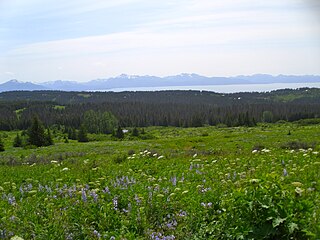
Diamond Ridge is a census-designated place (CDP) just outside Homer in Kenai Peninsula Borough, Alaska, United States. At the 2010 census the population was 1,156, down from 1,802 in 2000.
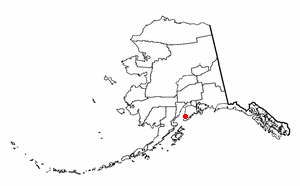
Homer is a city in Kenai Peninsula Borough in the U.S. state of Alaska. It is 218 mi (351 km) southwest of Anchorage. According to the 2020 Census, the population is 5,522, up from 5,003 in 2010. Long known as the "Halibut Fishing Capital of the World", Homer is also nicknamed "the end of the road", and more recently, "the cosmic hamlet by the sea".
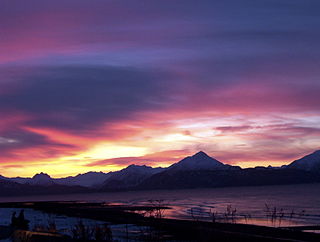
Kachemak Bay is a 40-mi-long (64 km) arm of Cook Inlet in the U.S. state of Alaska, located on the southwest side of the Kenai Peninsula. The communities of Homer, Halibut Cove, Seldovia, Nanwalek, Port Graham, and Kachemak City are on the bay as well as three Old Believer settlements in the Fox River area, Voznesenka, Kachemak Selo, and Razdolna.

The Alaska Peninsula is a peninsula extending about 800 km (497 mi) to the southwest from the mainland of Alaska and ending in the Aleutian Islands. The peninsula separates the Pacific Ocean from Bristol Bay, an arm of the Bering Sea.

Klondike Gold Rush National Historical Park is a national historical park operated by the National Park Service that seeks to commemorate the Klondike Gold Rush of the late 1890s. Though the gold fields that were the ultimate goal of the stampeders lay in the Yukon Territory, the park comprises staging areas for the trek there and the routes leading in its direction. There are four units, including three in Municipality of Skagway Borough, Alaska and a fourth in the Pioneer Square National Historic District in Seattle, Washington.

The Alaska Maritime National Wildlife Refuge is a United States National Wildlife Refuge comprising 2,400 islands, headlands, rocks, islets, spires and reefs in Alaska, with a total area of 4.9 million acres (20,000 km2), of which 2.64 million acres (10,700 km2) is wilderness. The refuge stretches from Cape Lisburne on the Chukchi Sea to the tip of the Aleutian Islands in the west and Forrester Island in the southern Alaska Panhandle region in the east. The refuge has diverse landforms and terrains, including tundra, rainforest, cliffs, volcanoes, beaches, lakes, and streams.

The Maryland Center for History and Culture (MCHC), formerly the Maryland Historical Society (MdHS), founded on March 1, 1844, is the oldest cultural institution in the U.S. state of Maryland. The organization "collects, preserves, and interprets objects and materials reflecting Maryland's diverse heritage". The MCHC has a museum, library, holds educational programs, and publishes scholarly works on Maryland.

The Anchorage Museum is a large art, history, ethnography, ecology and science museum located in a modern building in the heart of Anchorage, Alaska. It is dedicated to studying and exploring the land, peoples, art and history of Alaska.

Founded in 1964, Kenai Peninsula College (KPC), is a unit of the University of Alaska Anchorage with four locations on Alaska's Kenai Peninsula and Anchorage.

The Homer Spit is a geographical landmark located in Homer, Alaska on the southern tip of the Kenai Peninsula. The spit is a 4.5-mile (7.2 km) long piece of land jutting out into Kachemak Bay. The spit is also home to the Homer Boat Harbor. The harbor contains both deep and shallow water docks and serves up to 1500 commercial and pleasure boats at its summer peak. Additional features and attractions include The Nick Dudiak Fishing Lagoon, which is an artificial "fishing hole", campgrounds, hotels, and restaurants and the Salty Dawg Saloon, which is constructed out of several historic buildings from Homer. Hundreds of eagles formerly gathered there in winter to be fed by Jean Keene, the "Eagle Lady". The Spit features the longest road into ocean waters in the entire world, taking up 10–15 minutes to cover by car.
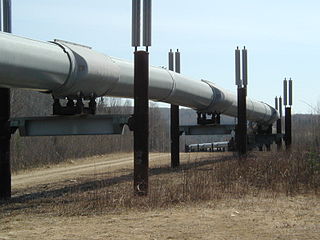
In a report compiled by the Alaskan Government, the real GDP of Alaska was $51.1 billion in 2011, $52.9 billion in 2012 and $51.5 billion in 2013. The drop-off that occurred between 2012 and 2013 has been attributed to the decline in the mining sector, specifically the oil and gas sectors, a consequence of declined production. The state's economy has been described by University of Alaska Anchorage economist Scott Goldsmith as a "three-legged stool" - with one leg being the petroleum and gas industry, the second leg being the federal government and the third leg being all other industries and services. Between 2004 and 2006, the federal government was responsible for 135,000 Alaska jobs, the petroleum sector provided 110,000 jobs and all other industries and services combined for 122,000 jobs.

Paleontology in Alaska refers to paleontological research occurring within or conducted by people from the U.S. state of Alaska. During the Late Precambrian, Alaska was covered by a shallow sea that was home to stromatolite-forming bacteria. Alaska remained submerged into the Paleozoic era and the sea came to be home to creatures including ammonites, brachiopods, and reef-forming corals. An island chain formed in the eastern part of the state. Alaska remained covered in seawater during the Triassic and Jurassic. Local wildlife included ammonites, belemnites, bony fish and ichthyosaurs. Alaska was a more terrestrial environment during the Cretaceous, with a rich flora and dinosaur fauna.
Virginia Hill Wood was an American environmental activist and a pioneer in the Alaskan conservation movement. Ginny Wood co-founded the Alaska Conservation Society in 1960 with her then husband, Morton "Woody" Wood.
The Alutiiq Museum or Alutiiq Museum and Archaeological Repository is a non-profit museum and cultural center dedicated to preserving and sharing the cultural traditions of the Koniag Alutiiq branch of Sugpiaq ~ Alutiiq of the Alaska Native people.
Kesler Edward "Kes" Woodward is an American artist, art historian and curator. Known for his colorful paintings of northern landscapes, he was awarded the first Alaska Governor's Award for Lifetime Achievement in the Arts in 2004. Woodward has also written extensively on the Art of the circumpolar North and has curated exhibitions which have toured Alaska, California, Oregon, Washington, and Georgia.

Attila Kuno "Atz" Kilcher is the oldest son of Yule F. Kilcher and Ruth Weber. He is one of the stars on the Discovery show Alaska: The Last Frontier, which focuses on the Kilcher homestead established 80 years ago outside of Homer, Alaska on Kachemak Bay.
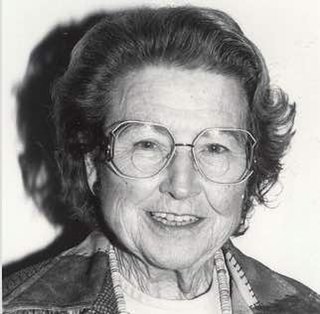
Hazel P. Heath was an American politician and an entrepreneur who manufactured and sold gift boxes of jams and jellies made of wild local berries from Homer, Alaska. She founded "Alaska Wild Berry Products" with her husband Ken in 1946. The couple also owned an art shop and gallery, and she was arts and crafts editor for Alaska magazine. Heath served as mayor of Homer for eight years, and was a National Republican delegate and a member of many local, state and federal boards and commissions. She was a founder of the Pratt Museum, and was the first woman president of the Alaska Municipal League Conference of Mayors. The Homer Chamber of Commerce named her the 1977 "Citizen of the Year", and the University of Alaska honored her with a Meritorious Service Award in 1989.

Smith Bay is an estuary in the Beaufort Sea that supports a wide range of fish, birds, and marine mammals. It is located northeast of Point Barrow, Alaska. The Bureau of Ocean Energy Management recognizes the southeastern portion of Barrow Canyon, which covers some, but not all, of Smith Bay, as an Environmentally Important Area.
Yule Forenorth Kilcher was a Swiss-born American homesteader who was a member of the Alaska state senate from 1963 to 1966.
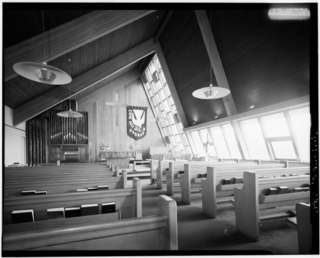
Edwin Butler Crittenden (1915-2015) was an American architect practicing in Anchorage, Alaska. Referred to later in life as the "dean of Alaska architecture," Crittenden was the most notable Alaskan architect of the twentieth century.

















